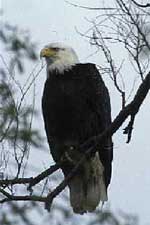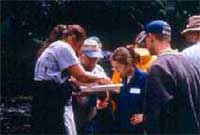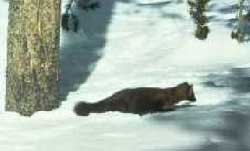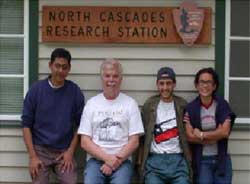|
North Cascades
Resource Management and Science Update Issue Number 2, August 2002 |

|
North Cascades National Park will be collaborating with the other National Park Service areas within the North Coast & Cascades Network to produce a fall newsletter. Members of this Network include North Cascades National Park Service Complex, Mount Rainier National Park, Olympic National Park, Fort Clatsop National Memorial, Fort Vancouver National Historic Site, and San Juan Island National Historical Park.
If you would like more information or would like to contribute articles, please send them to Paula_Ogden@nps.gov.
NATURAL RESOURCES
Status of Whitebark Pine in North Cascades and Mount Rainier National Parks
Whitebark pine is a keystone species of high-elevation ecosystems in the Pacific Northwest. It is a pioneer species on exposed sites with harsh climates and environmental conditions. Its establishment modifies the microclimate on these sites, enabling other species such as subalpine fir (Abies lasiocarpa) to gradually establish in these areas. On a landscape level, its presence affects snow accumulation, retention, and drainage patterns. The species is also an important food source for nutcrackers, grizzly bears, red squirrels, and several small mammals. It is also highly susceptible to infection and mortality by blister rust. Blister rust (Cronartium ribicola) is a fungus that was introduced to the United States from Eurasia in 1921. It has severely threatened the long-term survival of white pines native to North America. By 1946, the susceptibility of white pines to this disease and its rate of spread were evident.
Over the last decade, surveys of whitebark pines conducted in the Rocky Mountains and Glacier National Park have documented mortality rates of up to 99%. The surveys also found that mortality rates are distinctly related to geographic location and environmental conditions (Keane and Arno, 1993). These results indicate that ecosystem-specific surveys are necessary to evaluate local stand status. Surveys conducted in Mount Rainier National Park corroborate these findings. About 73% of all whitebark pine stands surveyed in MORA are infected with blister rust, but there was great variability in stand reproduction and mortality rates. In 2000, 10 whitebark sites in North Cascades National Park were surveyed for evidence of blister rust. All stands had infected trees, but rates of infection and mortality were highly variable. Rates of mortality ranged from 1% at Dee Dee Lakes to 93% at Skymo. Future studies looking at resistance to blister rust and fire history are needed to assess the potential for long-term survival of whitebark pine in North Cascades and Mount Rainier National Parks.
Written by Dr. Regina Rochefort, Science Advisor for North Cascades National Park. For more information, contact Regina Rochefort 360/856-5700 extension 254.
Upper Skagit River Bull Trout Radio Tracking Study
A bull trout study is currently being conducted in the upper Skagit River drainage by Seattle City Light, the National Park Service, U.S. Forest Service, British Columbia Parks, and the British Columbia Ministry of Water, Land and Air Protection. This joint project is being led by fish biologist Dr. Ed Connors of Seattle City Light. The project's objectives include investigating the distribution, life history, genetics, and migration behavior of native char in Ross Lake and tributaries in the United States, and in the Skagit River drainage in British Columbia. A radio telemetry study was initiated in 2001 as part of this project to identify and evaluate the migration patterns of spawning bull trout residing in Ross Lake.
Bull trout in Ross Lake attain relatively large sizes, with adults ranging from approximately 45 to 90 cm in length. A total of 15 bull trout were captured during the fall of 2001, surgically implanted with radio transmitters, and then released. Radio transmitters were implanted in five fish captured in Ross Lake at the mouths of key tributaries (Ruby Creek, Lightning Creek, and Big Beaver Creek), and in ten fish captured in the Skagit River in British Columbia. The radiotagged fish were monitored on a continuous basis from two radiotelemetry stations located on the upper Skagit River and a third radiotelemetry station located on Ruby Creek. Fish were also tracked from mobile receivers.
Adult bull trout started to stage at the tributary mouths of Ross Lake in late August and early September. Because of low flow conditions during the fall of 2001, most of these fish did not migrate upstream and initiate spawning until the second week of October. The upstream migration of bull trout into their spawning areas was triggered by rapidly increasing flows and declining water temperatures. Several bull trout holding in Skagit River just above Ross Lake migrated between 10 and 20 km in two days to the upper Skagit River to spawn. Other fish radio-tagged in the Skagit River, mostly smaller males, remained in the lower section of this river throughout the spawning period. Fish radiotagged at the mouths of Lightning and Big Beaver creeks migrated through Ross Lake and into the Ruby Creek drainage to spawn. This migration could have been caused by passage barriers that formed in Lightning and Big Beaver creeks during the drought conditions occurring in the fall of 2001. A key finding of the study to date is that adult bull trout migrate substantial distances in upper Skagit River drainage including Ross Lake and will move from one tributary system to another to spawn.
Written by Dr. Ed Conners, Fish Biologist with Seattle City
Light.
For more information contact Education Specialist Paula
Ogden, 206/386-4495 extension 19.
Historic Fire and Forest Dynamics in Thunder Creek Watershed, North Cascades National Park
Because national parks are created to protect our natural resources, it is tempting to believe that these resources — the mountains, rivers, forests, and wildlife — will remain unchanged while the lands outside park boundaries continue to be fragmented and disturbed by human activities. Even within national parks, the law of the land is change. Natural disturbances such as fires, windstorms and floods frequently disrupt park ecosystems. Human disturbances such as recreational impacts, air pollution and now possibly global warming, also can and do permeate park boundaries. And long before the term "global warming" was coined, climate and weather patterns fluctuated over time, causing a cascade of changes in glacier coverage, river flow, forest ecosystems, and wildlife populations.
Susan Prichard and David L. Peterson are studying a unique watershed, poised between the moist west side and the dry east-side of the North Cascade Mountains. Because the watershed is in a transitional climate, disturbance regimes and forest dynamics may be quite different from typical west or east-side ecosystems. They are conducting two research projects in Thunder Creek watershed to evaluate past forest fires and forest ecosystem dynamics. The first study is located on the western aspect of Ruby Mountain and evaluates how forests developed following a series of fire events around 130 years ago. The second study is a reconstruction of fires and forests from lake sediments, dating from ancient times (around 9000 years ago) to the present. Lake sediments were sampled from the Panther Potholes, located on Fourth of July Pass, and are being analyzed for charcoal fragments (with which we can infer past fire frequency), fossilized conifer needles and tree pollen. The result will be a detailed record of forest fires and vegetation change over the past 9000 years.
They expect that their two studies will demonstrate how changeable and dynamic fires and forests are in the North Cascades National Park. Park resource managers will use information gained from our research to better understand fire regimes and predict how forests and fires may change under future global warming scenarios. In particular, very little is known about natural fire regimes in North Cascades National Park, and our work will provide park managers with basic information regarding the past frequency of fires and forest regeneration patterns following fire. They expect to see some results in late 2002.
Written by Susan Prichard and David L. Peterson. Susan is a Ph.D. candidate at the College of Forest Resources, University of Washington. David is a Research Forester with the USDA Forest Service Pacific Northwest Research Station Fire and Environmental Research Applications Team and professor of forest ecology at the College of Forest Resources, University of Washington. The Canon National Parks Science Scholars Program and the USGS Global Change Program funded this research.
For more information, contact Science Advisor Regina Rochefort 360/856-5700 extension 254
Monitoring Long-term Trends of Bald Eagles Wintering on the Skagit River, Washington
 Adult Bald Eagle, Skagit River |
The Skagit River, flowing from Canada through North Cascades National Park Service Complex to Puget Sound, hosts one of the largest wintering bald eagle concentrations in the continental United States. Each winter since 1982, the National Park Service and The Nature Conservancy have jointly monitored bald eagle use of a 43-km reach of the Skagit River. Biologists have focused efforts on detecting temporal and spatial changes in eagle numbers, how the proportion of immature to adult eagles changes, and identifying relationships between the number of spawning salmon, Skagit River flow, recreational use, and the wintering eagle population.
Over the past two decades, annual eagle detections have increased (low - 77 in 1983-84, high - 506 in 1991-92.), but this trend has not been linear. Detections increased most rapidly from 1987-92, but since 1992 have averaged about 36% below the 1991-92 peak. The increase in eagle detections has been most pronounced on the upper 24-km reach. Increases in chum salmon spawning along this reach may have resulted in proportionately greater eagle use of this area. Before 1989, the size of the Skagit chum salmon run was positively correlated with eagle detections (r = 0.81, P = 0.002), whereas frequency of peak flow events on the Skagit was negatively correlated (r = -0.81, P = 0.003). These relationships have weakened since 1988 (r = 0.58, P = 0.05, and r = 0.40, P > 0.10). Low salmon escapements on several nearby rivers between 1989-93 coincided with a peak in eagle detections on the Skagit. A subsequent rebound in these other salmon runs coincides with a return to lower eagle detections on the Skagit. The proportion of subadult eagles in the Skagit population has declined over the last 2 decades, and may reflect changes in the age structure of the regional population in the Pacific Northwest. We found no correlation (r = 0.25, P > 0.10) between recreational use, as measured by private and commercial boat permits, and eagle detections.
Written by Robert C. Kuntz II, Wildlife Biologist, North Cascades National Park Service Complex.
For more information, contact Robert Kuntz 360/856-5700 extension 368.
 Melanie Graham and Dick Knight training Skagit River Stewards |
Skagit River Stewards to Begin Remarkable Sixth Year
The Skagit River Stewards Program, established in 1997, is a partnership between the North Cascades Institute, the National Forest Service, North Cascades National Park, and the Skagit Fisheries Enhancement Group.
This program measures changes in the health of the Skagit Wild and Scenic River corridor, which extends 158.5 miles from Sedro-Woolley, WA, east to Bacon Creek and south of Darrington. It includes portions of the Skagit, Sauk, Suiattle, and Cascade rivers.
This program has two objectives: 1) educate adults about aquatic resources, and 2) initiate biologic monitoring in the Skagit Basin. To meet these objectives, thirty adult volunteers, ranging in age from 18-60, receive 20 hours of training that teaches watershed dynamics, aquatic macroinvertebrate ecology, salmonid lifecycles, and sampling techniques. Training is coordinated by North Cascades Institute and conducted by staff from the Mount Baker-Snoqualmie National Forest and North Cascades National Park.
In return for their training, the Stewards volunteer 20 hours from August through September to monitor streams and collect aquatic macroinvertebrates. These organisms are preserved in the field and later identified by an aquatic ecologist from North Cascades National Park. The data collected in the Skagit is part of an effort to create a regional aquatic macroinvertebrate data set, which links the health of aquatic communities with the condition of their habitat and provides the Skagit Fisheries Enhancement Group a way to measure the success of their stream restoration efforts.
Written by Greta Movassaghi, Aquatic Resource Specialist, Mount Baker-Snoqualmie National Forest.
For more information, contact Aquatic Ecologist Ashley Rawhouser, 360/856-5700 extension 373.
Rare and Elusive Forest Carnivores
 American marten |
Little is known about the population status, distribution and abundance of forest carnivores in North Cascades National Park Service Complex (NOCA). This assemblage of carnivores includes the American marten, lynx, wolverine, fisher, and bobcat. By virtue of their position reigning at the top of the food chain, biologists have a vested interest in the conservation of these rare and secretive animals. They are an important group of mammals to monitor, since the health of their populations is dependent on the health of lower-trophic organisms that they prey upon.
Field studies investigating the presence/absence of these species in NOCA is scheduled to begin during the winter of 2002-2003. Non-invasive sampling methods such as motion-sensitive cameras will be used to detect and monitor the targeted species. The initial study is expected to continue for 2 years, which, through evaluation of the information collected, may form the basis for a long-term monitoring strategy.
For more information, contact Wildlife Biologist Roger Christophersen, 360/856-5700 extension 308.
Natural Resources Education
In the Field with Northwest Indian College
For three full days in June, students from Northwest Indian College's Tribal Environmental and Natural Resource Management Program shared time with park educators, researchers from the Cultural and Natural Resource Divisions, and bird biologists visiting from Nicaragua and El Salvador. While travelling over land and water, students learned about North Cascades' biodiversity, current archeological and geological studies, and international migratory songbirds.
North Cascades National Park and Northwest Indian College will continue working together during future sessions of this program.
Ornithologists from Nicaragua and El Salvador Visit North Cascades National Park
 from left to right: Roberto Rivera, Bob Kuntz, Edgar Castaneda, Alejandra Martinez |
Last month, North Cascades National Park hosted three ornithologists from Central America. In their home countries Roberto Rivera, of El Salvador, and Alejandra Martinez and Edgar Castaneda, of Nicaragua, educate local people and visitors about the importance of protecting songbirds and songbird habitat. The biologists spent two weeks in North Cascades learning about surveying techniques used to study the area's resident and migratory songbirds. The ornithologists made several presentations during their stay, including a talk with Northwest Indian College students and Skagit County Spanish-speaking residents.
Many species of songbirds that breed and raise young in North Cascades National Park travel from great distances — some birds come from as far away as Roberto, Alejandra, and Edgar. The long distance migration of these birds inspires wonder and shows that rather than being an isolated island of wild land, North Cascades is connected to seemingly far away places through the migration of birds and mammals.
For more information, contact Wildlife Biologist Bob Kuntz, 360/856-5700 extension 368.
To learn more about North Cascades National Park and some of these research projects, explore the website http:// www.nps.gov/noca.
noca/resource-mgt/august-2002.htm
Last Updated: 31-Aug-2002